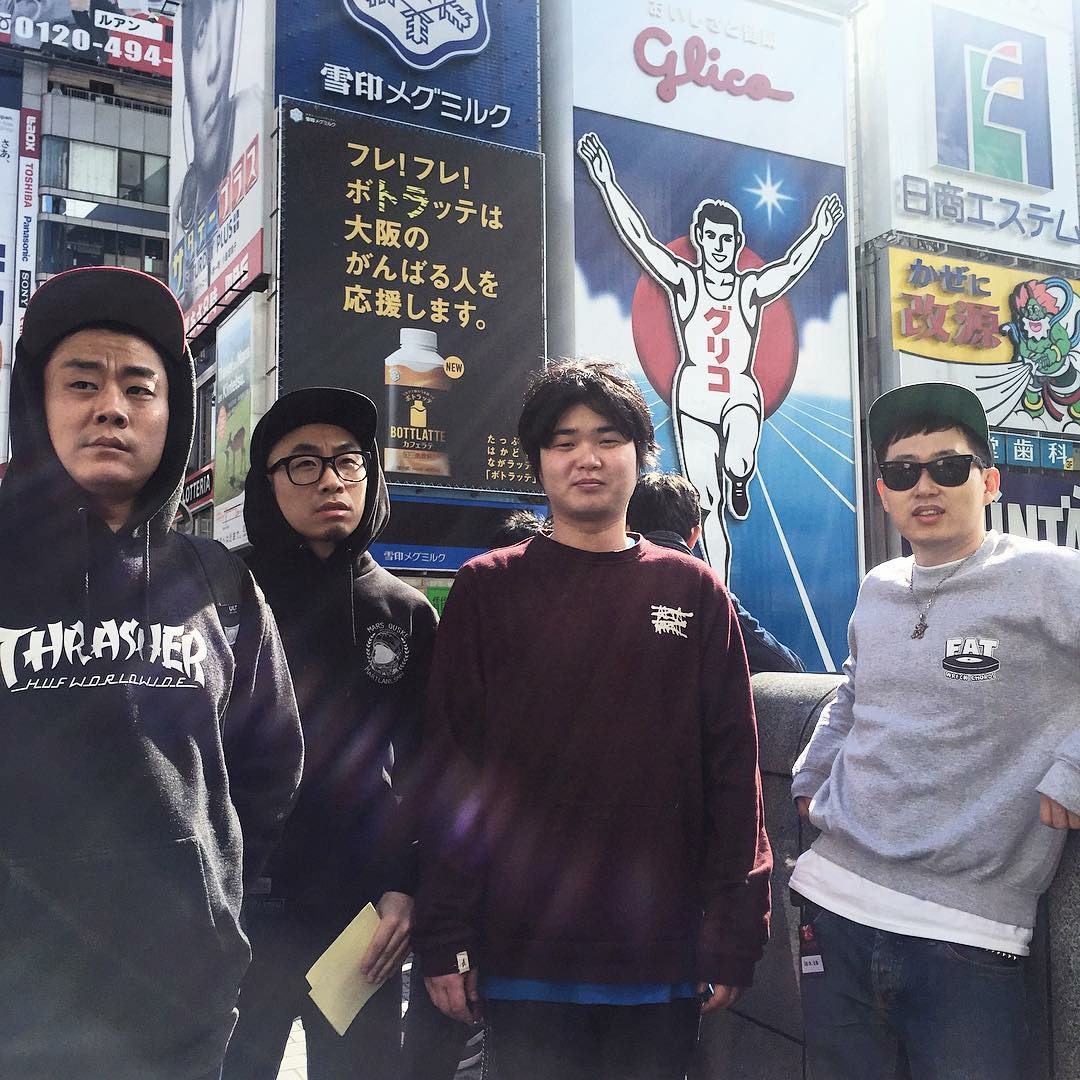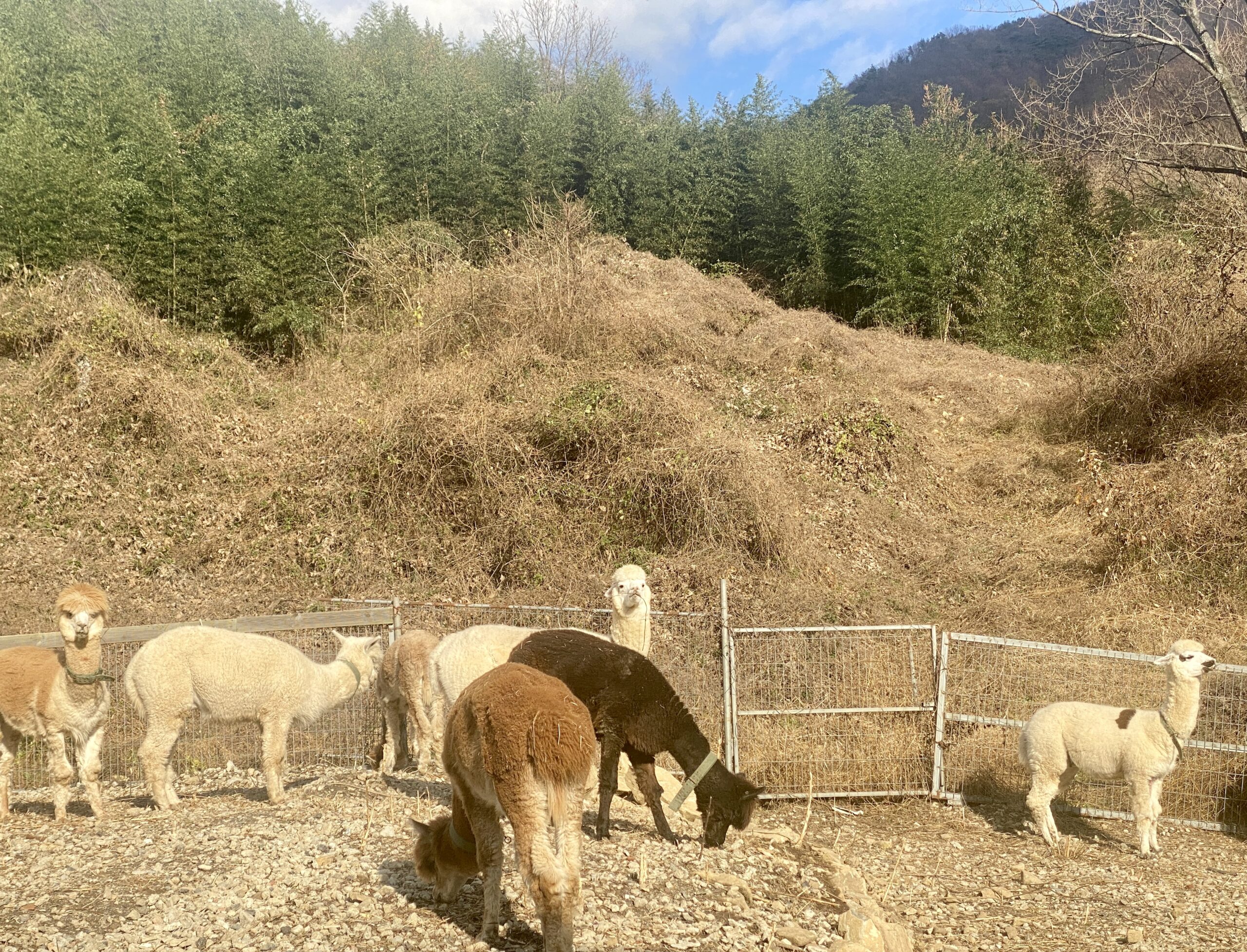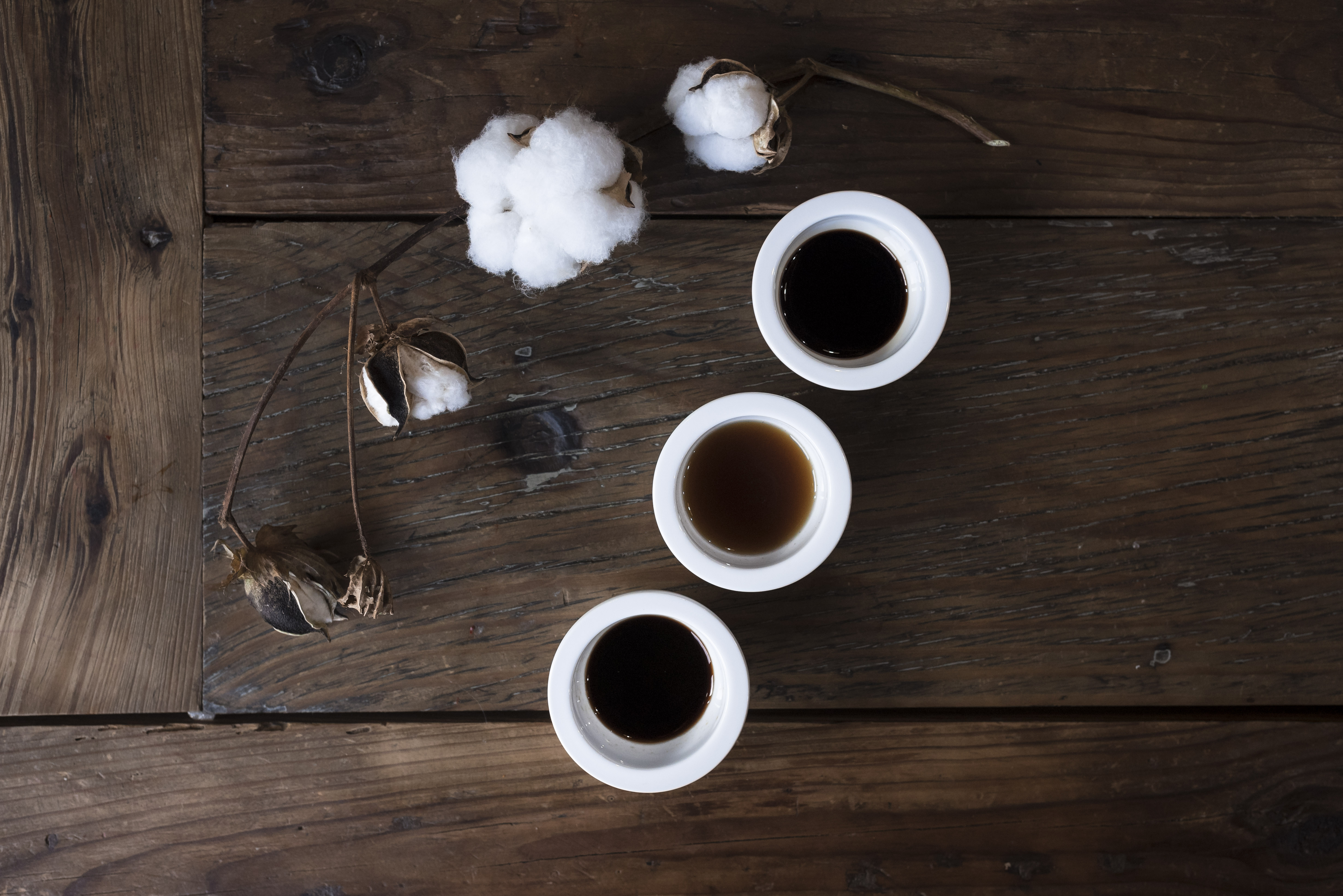Slow Delights: Master Ki Soon Do
 Written by Karly Pierre
Written by Karly Pierre
Photographed by Lorryn Smit
The road to Changpyeong is flanked by harvested fields. Mountains rise in the distance. The trees have lost their colorful fall leaves, and bright orange persimmons dangle from bare branches. An old lady wrapped in a puffy coat and warm hat slowly drives her scooter around a curve in the road. It’s a clear day, but biting cold. She passes a low-slung traditional house in the village and a sign pointing down an inconspicuous road leading to the headquarters of the Korea Traditional Food Company, owned by Mrs. Ki Soon Do. That’s where we turn.
Changpyeong has been designated a “Slow City” since 2007 to acknowledge the little village’s dogged preservation of fading Korean traditions. Mrs. Ki champions a tradition essential to Korean cuisine: fermented sauces.
At the entrance to the headquarters is a garden filled with hundreds of clay pots (onggi hangari, 옹기 항아리). They are fat and dark brown, beautifully arranged in long neat rows. Bunches of radish leaves (shiraegi, 시래기) sway under a gazebo as they hang out to dry in the early winter air. A worker in a white hairnet and full-length apron walks out of the front office to greet us. We follow her up a set of stairs to a hanok house overlooking the garden of pots. At the top of the stairs is a white Jindo dog. He lifts his head, his sagging eyes inquisitive, then lies down again, assured of our unimportance. Mrs. Ki is waiting inside the hanok and offers us a plate of sweet delicacies: bellflower root (doragi, 도라지) and persimmon covered in golden grain syrup (jocheong, 조청), roasted rice cake paired with darker grain syrup dipping sauce (ssal jocheong, 쌀 조청), honey cookies (yakgwa, 약과), and homemade sweet rice drink (ssal sikhye, 쌀 식혜). As the interview begins, my translator is a little flustered.
“Because you’re famous,” she says to Mrs. Ki, who smiles softly and shakes her head.
Mrs. Ki is something of a celebrity on the Korean food scene. She was given the title of “master” in 2008 by the Korean Food Grand Master Organization, and her products are praised by internationally renowned chefs such as Damien Duquesne. Her prized 360-year-old ganjang (간장, soy sauce) was the highlight of a recent state dinner for President Donald Trump.
But the beginning of her love affair with food is a modest one that started as a child at the dinner table with her family. Her father was a Confucian scholar who imparted a strict sense of filial duty to all five of his children.
“When my great-grandmother passed away, we built a house next to her grave and lived there like a dutiful family,” Mrs. Ki explains. “The local government tried to give my father an award for his integrity, but he wouldn’t accept it because he thought this was every child’s basic obligation.”
Her family lived in the countryside and was considered well off, so maids prepared many of the family meals. However, every girl in the household was expected to learn to cook.
“I don’t remember when I started cooking because I was so young, but I learned a lot from my mother,” says Mrs. Ki. “She never used pickled shrimp or fish, so the taste of another person’s kimchi was unusual to us. My mother made foods like kimchi and sauces seasonally. I fondly remember when she made fermented bean-paste soup (cheonggukjang, 청국장) for us.”
Mrs. Ki’s marriage in 1972 to Ko Gab-seok was pivotal in shaping her future culinary career. Mrs. Ki and Ko met through a matchmaker.
“In my generation, women didn’t leave the house often, so my mother taught us at home using the books that had been in the family for generations. There was no such thing for us as going on dates. People had arranged marriages, and the most important requirement for a woman was to be able to do housework well. It took three years for a matchmaker to find me a match. My mother told the matchmaker that I couldn’t even cook rice, so my mother-in-law thought I couldn’t do anything. But when I gave her my kimchi to taste, she was shocked by how delicious it was.” Mrs. Ki laughs.
Her husband graduated from Gwangju High School and later majored in Buddhism at Dongguk University. Before marrying, he studied in the mountains as a monk and developed a taste for the roasted bamboo salt that monks ate there. With his wife, he practiced and refined the technique of packing salt in winter bamboo and roasting it over a pinewood fire.
Bamboo imbues salt with a subtle sweetness and clarity. Though Mrs. Ki’s husband died in 1999, the family has continued using bamboo salt to give their doenjang (bean paste) and ganjang (soy sauce) its distinctive flavor.

“At first, my son refused to roast salt, but now he’s very diligent,” says Mrs. Ki. “When we roast the bamboo salt, we create lots of smoke, so we moved to this part of the village so we don’t disturb the neighbors. In front of our house is the graveyard of five generations of our family.”
As the wife of the eldest son, Mrs. Ki received cherished family recipes from her mother-in-law. She was also given a vessel of the family’s oldest ganjang – now 360 years old. Until recently, passing along ganjang as a family heirloom was a common tradition in noble Korean families. As ganjang ages, it becomes thicker, sweeter, and more complex.
Korean ganjang is the byproduct of fermenting doenjang. The process of making doenjang begins in winter and takes about one year to complete. “We traditionally make meju (soybean blocks, 메주) in winter because, if you think about it, there are no flies or bugs, so it’s really the best time to make it,” says Mrs. Ki. “Our ancestors were really wise to think of everything in such great detail.”
Mrs. Ki says there are three necessities for making good doenjang: good soy beans, good water, and good salt. In the past, she says, ganjang was considered a medicine because it contained beans and water, and took so much time to make.
To begin the process, soybeans are boiled, mashed, and pressed into meju blocks that are hung to dry with rice straw rope. The straw attracts the bacteria needed for fermentation. Mrs. Ki ferments her meju for about one month. The meju blocks are then placed in clay pots with water, salt, jujubes, dried red peppers, and charcoal, and then fermentation continues. Mrs. Ki uses natural bedrock water drawn from 150 meters below ground. Fifty days later, the meju blocks and the water byproduct are separated. The soaked meju blocks are mashed and mixed with meju powder, then placed back in clay jars to continue fermenting as doenjang. The water byproduct is placed in another clay jar and after one year becomes the light amber ganjang known as sijang. ganjang fermented for five years is a darker rich color and known as jinjang.
Mrs. Ki says that nature and the Jeolla Provinces’ unique character contribute to the taste of her doenjang and ganjang. Clay pots, she points out, affect the taste of the sauce. The shape of clay pots can vary from region to region, and Jeolla’s distinctly fat and heavy clay pots are the secret to the region’s exceptional culinary reputation.
“The taste of the sauce differs if the clay used in making the pot is not good or not baked properly. The pots have to receive enough sunshine, and they have to be cleaned and managed well… From the pine trees surrounding our village, we get pine pollen in spring, and when we combine it with the sauce, it tastes delicious.”

There are many superstitions surrounding the process of making doenjang and ganjang. For instance, the best time to make meju is on the winter solstice (Dongji). Also, those preparing doenjang or ganjang should be in a positive mindset. And most notably, Mrs. Ki says no one who has just attended a funeral should take part in the preparation of doenjang or ganjang because it would change the taste of the sauce.
“In the past, people thought that if the sauce’s taste changed, there would be misfortune in the family. So, on the days when they made the sauce, they needed to bathe more thoroughly and pray. Since sauce was made once a year for a household, if anyone made a mistake in the process, the family would have to eat bad-tasting food for the whole year.”
Since founding the Korea Traditional Food Company in 1992 with her husband, Mrs. Ki’s products have become popular on grocery shelves throughout the country. Mrs. Ki’s ganjang was given the K-Ribbon certification, a national award given to culturally significant products. In addition to doenjang and ganjang, she also sells grain syrup, ssamjjang, bamboo salt, shikhye and gochujang—including strawberry gochujang.
“Damyang is quite famous for strawberries, so we thought why not use them. Strawberry gochujang (딸기고추장) is mild, so both foreigners and children like its taste.”
Mrs. Ki is happy that her children are involved with the company and eager to continue the family tradition. All of her children are learning the family’s recipes, and before a fatal accident, one of her sons received a doctorate in sauce making.

“My children loved my kimchi when they were growing up,” says Mrs. Ki. “I prepared it exactly the way my mother did, seasonally and without sugar or pickled shrimp. My family prepares food very carefully… Even my grandchildren are interested in food and our business, so I’m not worried about the continuation of this tradition when I pass on.”
She notes the dearth of quality traditional sauces available to Korean consumers and how her customers express a desire for the continued success of her company. With the nation’s change to a fast-paced lifestyle, slow foods can be out of step.
“Most people tend to live in apartments and big buildings where it’s difficult to make sauce. To be delicious, the sauce must get adequate sunlight. That’s why these days it’s difficult to find delicious ganjang. People add salt and pickled shrimp to give it flavor. High quality ganjang is sold at department stores, but not everyone can afford it, so people simply just use salt to flavor their food. It’s unfortunate.”
As we leave Mrs. Ki’s hanok and say goodbye, I point to her dog. He’s lying in the same spot, staring off at the garden of clay pots topped with stones – one for ganjang, two for doenjang and three for gochujang. Mrs. Ki shakes her head to assure me that he’s no threat, but I’d already concluded that he couldn’t muster the energy to be a vicious killer. He’s as slow as the rest of the village.
“What’s his name?” I ask.
“Ahh.” She smiles. “Bokgu.”
In Korean, bokgu means “restore.”
I walk past Bokgu and wave goodbye. He scratches behind his ear and goes back to sleep.
The Author
Karly Pierre has an MA in Mass Communication and has worked as an editor and writer for several publications. She is currently an assistant professor in the ESL department at Chosun University.
Burdock Soup 우엉탕
Written and photographed by Karly Pierre
Burdock root has been traditionally used in many cultures for a variety of medicinal purposes. Burdock is believed to be a blood purifier, heal skin ailments, and increase libido. In Korea, burdock tea is popular, but it is also used as an ingredient in soups.
1/2 burdock root (ueong, 우엉)
2 tablespoons soup soy sauce (cheongjang, 청장)
2 tablespoons perilla powder (deulkkae-garu, 들깨가루)
200 grams short necked clams (bajirak, 생 바지락살)
1 teaspoon minced garlic
3 cups water
chopped chives
water from washed rice
Peel the burdock, and slice diagonally. Then immediately soak the cut burdock in a bowl of cold washed-rice water. This will prevent the burdock from turning black. After soaking for a few minutes, put the burdock and soup soy sauce in a soup pot, and add 3 cups of water. Simmer the burdock. When the burdock is soft, add perilla powder, garlic, and clams. Boil the soup on high heat. Serve the soup in a bowl, and garnish with chives. This recipe serves two people.





